Tom Wolfe (1931–2018)
The US writer, who died last week, brought a quality of inestimable importance to the modern novel: a mind that was wholly in tune with the times
The US writer, who died last week, brought a quality of inestimable importance to the modern novel: a mind that was wholly in tune with the times

The American writer, Tom Wolfe, who died last week aged 88, brought a quality of inestimable importance to the modern novel: a mind that was wholly in tune with the times.
Wolfe had a Doctorate in American Studies from Yale and an interest in social anthropology, that he explored, initially as a journalist, through the foot-slogging, cold-calling, cuttings-library research methods of fact-checked human interest journalism.
He worked first as a reporter for The Washington Post and later – with burgeoning fame – as a features writer for Esquire and New York magazine, covering the often crazily vivid new social phenomena of the 1960s and 1970s. His originality and brilliance as an investigative writer came from his combination of near forensic realism with the development of a prose style that was as revved, hysterical, fluorescent in sensibility and vivid in detail as the subjects he was writing about. The title of one of his early features for Esquire, ‘There goes (Varoom! Varoom!) That Kandy-Kolored Tangerine-Flake Streamline Baby’ established and exemplified this hitherto-unheard of style of modern journalism.
Hugely successful, these experiments in features writing would be the basis of his groundbreaking declaration of The New Journalism, in which the technical and stylistic capacities of fiction writing – language, narrative, dialogue, scene-setting, plot, psychological perspective, character – were brought to non-fiction subjects. In 1973 he co-edited with E. W. Johnson a selection of such writings under the title ‘The New Journalism’ – including work by Joan Didion, Hunter S Thompson and Truman Capote.

Wolfe’s particular genius lay in describing how the minutiae and influence of status consciousness, above all, was common to every strata of modern society; and how within this – the seemingly trivial machinations of fashion, from interior design to politics – lay the far greater subject of emotional honesty, the struggles with which shaped human destiny.
His sartorial dandyism – nattily dressed in white, with hat and cane – was an extension of his literary dandyism, the obsession with the eloquence of detail, the basis of which was usefully summarized in 1712 by the English Augustan poet, Alexander Pope, in his satire, ‘The Rape of The Lock’: ‘What mighty contests rise from trivial things!’
For it was the details of human behaviour, the tiny forgotten moments of hubris, the fleeting sensations – the chemical smell of a hotel conference room’s carpet squares – that somehow come to represent the spiritual epic of a person’s life, that Wolfe wove so compellingly into the engulfing, roller-coaster narratives of his moral comedies.
Wolfe believed passionately that the modern American novel was dying of starvation – that it needed substance, and substance came not from rarified navel-gazing, however focused, but from stories about the world out there – what was happening in the Bronx, or at the Playboy mansion, or at an art opening, or in a busy Wall Street office or a shifty law practice where the overhead lighting was so bright they had to take out half of the light bulbs.
What was needed, Wolfe maintained, was a return to the narrative values and psychological vistas opened up by the great European naturalist writers of the 19th century: Zola, Maupassant, Turgenev, Balzac. And to prove his point he published in 1987 his best-selling epic novel of contemporary Manhattan, The Bonfire of The Vanities – the first of a succession of novels that surveyed the immensity of America, from billionaires to college campuses to shift work in a frozen food warehouse in a sweltering suburb of Atlanta, Georgia.
He was an old school liberal humanist – a more secular Marshall McLuhan.
Through the auspices of this magazine and the chance recollection that Wolfe’s literary agent in New York had been an early collector of the work of Ray Johnson, I managed to meet Tom Wolfe in Paris, at the Hotel Georges Cinq in the summer of 2006. He was one of those people whose vital energy makes them seem more defined, more present in the moment than the rest of us.
He was dressed in white, was uncommonly charming and to cap it all sounded just like James Stewart in any of his leading roles – courteous, thoughtful, self-deprecating in an awe-shucks kind of way yet swift to make or pursue a point. Realizing that I was interviewing his for a leading journal of contemporary art, he began by saying, ‘Well, of course the idea that contemporary art has anything to say to the modern world is patently absurd.’
This seemed as refreshing as a sudden cool breeze through the hot Parisian afternoon. Like E. M. Forster, Wolfe saw how the hypocrisies of social discourse, whether covert, lazy, charming, dazzling or blatant, could be the harbingers of personal disaster and near cosmic disorder. Like all good cops, he knew that the truth is seldom pure and never simple.
He was an old school liberal humanist – a more secular Marshall McLuhan – fascinated by the modern world, and by the existential questions of how an individual lives and survives, making their moral choices amidst the vagaries of circumstances. How someone’s longing – a momentary impulse, perhaps – one hot summer’s day, to own a pair of Porsche brand sunglasses, might be the moment their very soul is accosted, their fate determined. And his writing compelled because it brought that moment to life, placed you in it – made you care.
Main image: Tom Wolfe seated at his desk. Photograph: Deborah Feingold



















